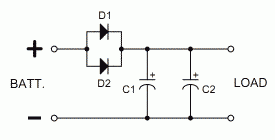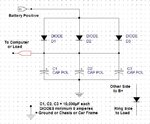
- Joined
- Apr 1, 2011
- Messages
- 15,579
- Helped
- 2,912
- Reputation
- 5,836
- Reaction score
- 3,049
- Trophy points
- 1,393
- Location
- Minneapolis, Minnesota, USA
- Activity points
- 116,681
The first schematic will not allow the capacitors to power the load.
By the way, in frigid cold it's conceivable that parts can shift inside a capacitor, either the wires or the paper/wax/chemicals, etc.
This can cause reduced ability to hold a charge, or at worst a short circuited capacitor.
Did you test that the caps can hold a charge in cold temp? Each cap independently?
And that they can provide 12 V to a load of maybe 1000 ohms? (Or based on whatever is your instrument's current draw.)
For several seconds?
By the way, in frigid cold it's conceivable that parts can shift inside a capacitor, either the wires or the paper/wax/chemicals, etc.
This can cause reduced ability to hold a charge, or at worst a short circuited capacitor.
Did you test that the caps can hold a charge in cold temp? Each cap independently?
And that they can provide 12 V to a load of maybe 1000 ohms? (Or based on whatever is your instrument's current draw.)
For several seconds?






